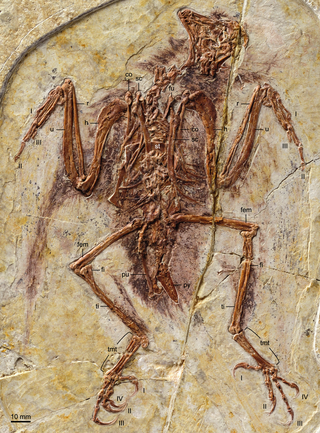
The Enantiornithes, also known as enantiornithines or enantiornitheans in literature, are a group of extinct avialans, the most abundant and diverse group known from the Mesozoic era. Almost all retained teeth and clawed fingers on each wing, but otherwise looked much like modern birds externally. Over eighty species of Enantiornithes have been named, but some names represent only single bones, so it is likely that not all are valid. The Enantiornithes became extinct at the Cretaceous–Paleogene boundary, along with Hesperornithes and all other non-avian dinosaurs.

Longipteryx is a genus of prehistoric bird which lived during the Early Cretaceous. It contains a single species, Longipteryx chaoyangensis. Its remains have been recovered from the Jiufotang Formation at Chaoyang in Liaoning Province, China. Apart from the holotype IVPP V 12325 - a fine and nearly complete skeleton — another entire skeleton and some isolated bones are known to date.
Boluochia zhengi was an enantiornithine bird. It lived during the Early Cretaceous in the time span 121.6-110.6 mya and is known from fossils found in the Jiufotang Formation of Liaoning province, People's Republic of China. Boluochia was first described by Zhou in 1995. A re-analysis of the specimen by Jingmai O'Connor and colleagues found that it was closely related to Longipteryx and could be assigned to the family Longipterygidae.
The Jiufotang Formation is an Early Cretaceous geological formation in Chaoyang, Liaoning which has yielded fossils of feathered dinosaurs, primitive birds, pterosaurs, and other organisms. It is a member of the Jehol group. The exact age of the Jiufotang has been debated for years, with estimates ranging from the Late Jurassic to the Early Cretaceous. New uranium-lead dates reveal the formation is deposited in the Aptian stage of the Early Cretaceous. Fossils of Microraptor and Jeholornis are from the Jiufotang.
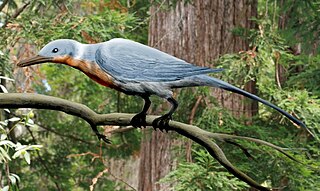
Shanweiniao is a genus of long-snouted enantiornithean birds from Early Cretaceous China. One species is known, Shanweiniao cooperorum. There is one known fossil, a slab and counterslab. The fossil is in the collection of the Dalian Natural History Museum, and has accession number DNHM D1878/1 and DNHM1878/2. It was collected from the Lower Cretaceous Dawangzhengzi Beds, middle Yixian Formation, from Lingyuan in the Liaoning Province, China.
Longicrusavis is an extinct genus of basal ornithuromorph bird found only at Dawangzhangzi village in Liaoning Province, China. Longicrusavis was a ground dwelling carnivore, a wader, and part of biological family Hongshanornithidae, considered to have been a dominant species in the Jehol Biota, the prehistoric Chinese ecosystem which supported them. The name Hongshanornithidae represents one of China's oldest recorded cultures in the region, the Hongshan culture.
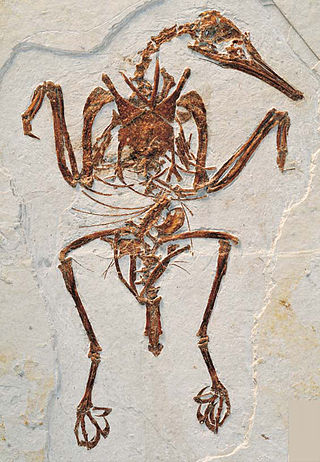
Rapaxavis a genus of enantiornithine bird. It has been found in the Jiufotang Formation in Liaoning, People's Republic of China.
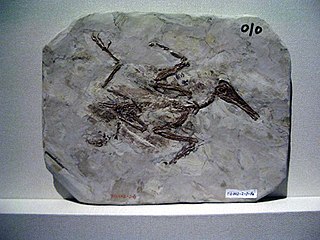
Longipterygidae is a family of early enantiornithean avialans from the Early Cretaceous epoch of China. All known specimens come from the Jiufotang Formation and Yixian Formation, dating to the early Aptian age, 125-120 million years ago.

Bohaiornis is a genus of enantiornithean dinosaurs. Fossils have been found from the Lower Cretaceous Jiufotang Formation of western Liaoning, China. The only known species, Bohaiornis guoi, was named by Dongyu Hu, Li Li, Lianhaim Hou and Xing Xu in 2011 on the basis of a fully articulated and well-preserved skeleton of a sub-adult. This specimen, LPM B00167, preserved two long, ribbon-like feathers attached to the tail rather than a fan of shorter pennaceous feathers. It was similar to the slightly older Eoenantiornis, but much larger in size. Bohaiornis is the type species of Bohaiornithidae, a family of large predatory enantiornitheans from the Early Cretaceous.
Parabohaiornis is an extinct genus of bohaiornithid enantiornithean dinosaur known from the Early Cretaceous of Liaoning Province, northeastern China. It contains a single species, Parabohaiornis martini.
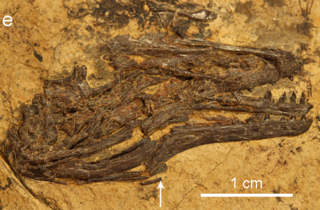
Longusunguis is an extinct genus of bohaiornithid enantiornithean dinosaur known from the Early Cretaceous of Liaoning Province, northeastern China. It contains a single species, Longusunguis kurochkini.
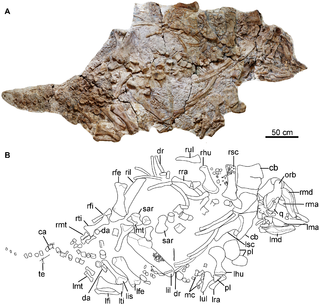
Chuanqilong is a monospecific genus of basal ankylosaurid dinosaur from the Liaoning Province, China that lived during the Early Cretaceous in what is now the Jiufotang Formation. The type and only species, Chuanqilong chaoyangensis, is known from a nearly complete skeleton with a skull of a juvenile individual. It was described in 2014 by Fenglu Han, Wenjie Zheng, Dongyu Hu, Xing Xu, and Paul M. Barrett. Chuanqilong shows many similarities with Liaoningosaurus and may represent a later ontogenetic stage of the taxon.

Parapengornis is an extinct genus of enantiornithine bird from the Lower Cretaceous of what is now China. The holotype specimen was discovered in the Jiufotang Formation near Lingyuan, western Liaoning province, and was catalogued as IVPP V18687. The nearly complete, articulated specimen is preserved on a slab and has impressions of pennaceous feathers. Only parts of the sternum, the left hand, and right foot are missing. In 2015, it became the basis of the new genus and species Parapengornis eurycaudatus, named by the Chinese palaeontologists Han Hu, Jingmai K. O’Connor, and Zhonghe Zhou. The generic name consists of the Latin word para and the name of the related genus Pengornis, indicating their close relationship. The name Pengornis is itself derived from "Peng", a mythological bird from Chinese folklore, and ornis, which means bird in Greek. The specific name is derived from the Latin words eury, meaning broad, and caudatus, meaning tail, in reference to the broad and expanded pygostyle. A nearly complete specimen formerly assigned to Pengornis was also reassigned to Parapengornis by these authors.
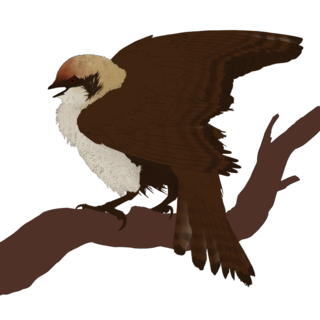
Chiappeavis is a genus of enantiornithean bird from Early Cretaceous of northeastern China. The only species is Chiappeavis magnapremaxillo. Chiappeavis is classified within the family Pengornithidae. It is known from a single, almost complete skeleton including feather impressions discovered in the Jiufotang Formation of the Jehol Group. Long feathers formed a fan-shaped tail that was probably employed in flight.
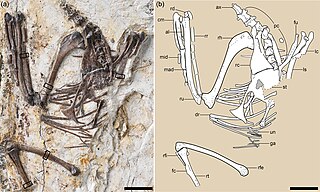
Mirusavis is a genus of Enantiornithes from the early Cretaceous of China recovered in the Yixian Formation. It contains a single species, Mirusavis parvus.

Yuornis is an extinct genus of enantiornithine bird known from the Late Cretaceous of Henan, China. It contains one species, Yuornis junchangi, named after the late Lü Junchang.
Musivavis is a genus of euenantiornithine bird from the Early Cretaceous (Aptian) Jiufotang Formation of Liaoning Province, China. The genus contains a single species, Musivavis amabilis, known from a nearly complete, articulated skeleton.

Cratonavis is an extinct genus of pygostylian avialian from the Early Cretaceous Jiufotang Formation of Liaoning Province, China. The genus contains a single species, C. zhui, known from a complete skeleton.

Meilifeilong is an extinct genus of chaoyangopterid pterosaurs from the Early Cretaceous Jiufotang Formation of China. The genus contains two species: M. youhao, known from an almost complete skeleton and a partial skull, and M. sanyainus, originally described as a species of Shenzhoupterus. The Meilifeilong youhao holotype represents the best-preserved and most complete chaoyangopterid discovered so far.
















